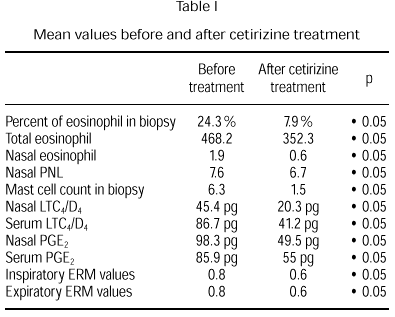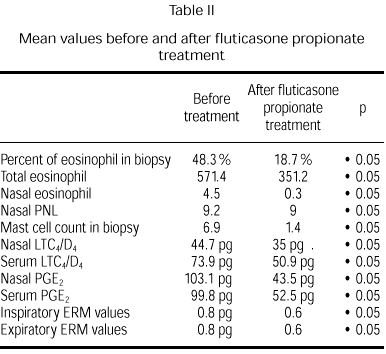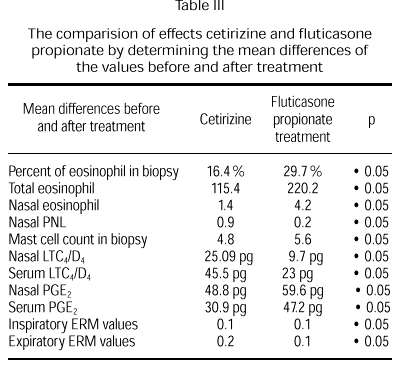INTRODUCTION
Allergic rhinitis is an IgE mediated hypersensitivity disease of nasal mucosa characterized by sneezing, nasal itching, rhinorrhea and nasal obstruction. For the last ten years, there has been an increase in the incidence of this health problem which is benign, but has a progressive disease. Although the cause of this increase is not known, it is presumed to be due to air pollution, increase of SO2, NO2 ratios and lost of ozone layer (1).
At present, antihistamines are among the most widely used pharmacological agents in the treatment of allergic rhinitis (2).
Cetirizine that is the main metabolite of hydroxyzine is a newly developed second-generation H1 receptor blocking agent. It is more selective than the others to the H1 receptors. At the same time, antiinflammatory effect of cetirizine has been suggested (3, 4).
In recent years, considerable attention has been paid to the treatment of the underlying inflammation of the nasal mucosa. Antiinflammatory agents such as topical corticosteroids with high topical effects and minimal side effects, has proven to be very effective in the treatment of nasal allergy and hyperreactivity, especially in eosinophil dominated nasal inflammation (5).
In this study, the topical intranasal corticosteroid (Fluticasone Propionate) was compared with Cetirizine which is thought to have antiinflammatory effects. The effects on the histopathology of the nasal mucosa before and after treatment with these two different agents were evaluated. Eosinophil counting in nasal secretion, nasal and serum PGE2 and LTC4/D4 levels, nasal airway resistance and total eosinophil counting were also determined.
PATIENTS AND METHODS
Fifty one patients (M/F = 21/30) referred to Departments of Otorhinolaryngology and Pediatric Allergy of Dokuz Eylül University Medical Faculty due to allergic rhinitis were included in this study that was conducted in between March 1996 and December 1997.
The inclusion criteria for the patients were:
1. No pathology except perenneal allergic rhinitis on the routine otorhinolaryngologic examination.
2. History, compatible with perenneal allergic rhinitis.
3. Physical examination, compatible with allergic rhinitis.
4. Patients with positive skin test at least to one allergen.
5. No treatment given for allergic rhinitis at least for the last two months.
6. Additionally, no other allergic disease like bronchial asthma which needed treatment before.
7. No additional sinonasal pathology found on paranasal sinus CT.
Eight patients (3 female and 5 male) were excluded, for not fitting all parameters and for not coming to follow up.
Thus, the study was completed with 43 patients (M/F = 16/17) with a mean age of 31.91 ± 41.55 years (range between 11 and 73). Before treatment and at the 45th day of treatment, total eosinophil and PNL count, eosinophil count in nasal smear, electrorhinomonometric (ERM) examination, PGE2 and LTC4/LTD4 levels on nasal secretion and serum were determined in all patients. Similary before and after treatment, biopsy from front part of middle choncha was made and evaluated for percentage of eosinophils and mast cell count. Twenty two patients (M/F = 2/20) were given 10 mg of Cetirizine as a single daily dose for 45 days. Twenty one patients (M/F = 14/7) were given 400 mg intranasal Fluticasone Propionate (FP) daily, in two divided doses for 45 days. The type of treatment given to the patients was chosen randomly.
After the physical examination of skin test positive patients and evaluation of the nasal resistance by ERM, firstly nasal secretions were aspirated without any provocation for determining nasal mediators and nasal eosinophils. After that, biopsy specimens obtained were from the front parts of middle chonchae following topical anesthesia, and the samples were sent to Pathology department inside the formaline for evaluating of mediators. For the evaluation of total eosinophil count in the serum and in nasal secretions, 5 ml of venous blood and nasal secretion samples were sent to the Microbiology and Pediatric Allergy Laboratories, respectively.
Before and after treatment, nasal airway resistance was measured by using mercury NR6 Rhinomanometre with active anterior rhinomanometre. For the skin test, noninvasive, easily used epidermal prick test was used.
Statistical Analysis
In this study, T test for paired samples and Wilcoxon Matched Pairs Signed Ranks Test were used for effects of these two treatment on the evaluated parameters. For comparision of the effects of two treatment models, Mann-Whitney U and Wilcoxon Rank Sum W Tests were used.
RESULTS
When the pre and post treatment values of patients in Cetirizine group were compared, the percentage of eosinophils and mast cell count in the biopsy speciments were determined to decrease significantly (p < 0.05).
Nasal eosinophil count, LTC4/LTD4 and PGE2 levels decreased significantly (p < 0.05), while PNL levels did not differ after treatment (p > 0.05).
Serum total eosinophil count, PGE2 and LTC4/LTD4 levels decreased significantly after treatment (p < 0.05). In addition, both inspiratory and expiratory ERM values decreased significantly after treatment (table I).
When the pre and the post treatment values of the patients in the FP group were compared, post treatment changes in the parameters were just like those in the Cetirizine group, except nasal LTC4/LTD4 level which didn't decrease significantly after treatment (p > 0.05) (table II).
When we compared the effect of Cetirizine and FP on the evaluated parameters, FP was found to be significantly more effective than Cetirizine in decreasing the number of eosinophil in the nasal biopsy specimens, nasal smear and in the blood (p < 0.05) (table III).
DISCUSSION
Allergic rhinitis is a nasal inflammatory disease. After exposure to allergens, IgE activated mast cells in the nasal mucosa release mediators, like histamine, leukotrienes, prostaglandins and bradykinin. These mediators work independently or in combination to cause symptoms of nasal obstruction, rhinorrhea, sneezing and nasal itching. Inflammatory cells like eosinophils accumulate in the nasal mucosa, causing nasal symptoms and hyperresponsiveness to the allergen (6). In allergic rhinitis the symptoms occur with the interaction of released mediators, and neural and vascular structures in the nasal mucosa (7).
Histamine released by mast cells and basophils is an important mediator in the pathophysiology of allergic rhinitis. After immunologic provocation of mast cells and basophils they produce same symptomatic effect by histamine release which acts through H1 receptors found in organs related with IgE mediated allergic reactions (8).
H1 antihistamines and corticosteroids are used wide spread in the treatment of allergic rhinitis. H1 antihistamines reduce the clinical expression of nasal itching, sneezing and rhinorrhea, but are relatively ineffective in the treatment of nasal obstruction. Corticosteroids inhibit all the symptoms including nasal obstruction (9).
Cetirizine, a hydroxyzine metabolite, is a second generation H1 antagonist with high specificity to H1 receptors, low metabolization level and H1 receptor unrelated effects on the cells involved in the pathophysiology of allergy. It is also known that it has antiinflammatory effect by preventing migration of the inflammatory cells like eosinophils, neutrophiles and basophils to the IgE mediated allergic reaction area (10). Cetirizine is the second line H1 antagonist which decrease the nasal congestion and also nasal obstruction.
Corticosteroids show antiinflammatory effect by decreasing capillary permeability and stabilizing the lysosomal membrane. They also decrease the late effects of allergic reactions by inhibiting the flow of arachidonic acid and blocking the effects of migration inhibitory factor (11). Because of the possible side effects they have to be used in minimal efficient therapeutic dosage for a short period and if possible topical preparations have to be used to decrease the risk of side effects and increase the therapic effects (12).
Nasal fluticasone propionate is an active, topical preparation. When the topical antiinflammatory activity of FP is compared with beclomethasone and triamcinolone acitonide it is 2 times and 9 times more effective, respectively. In appropiate dosage, systemic absortion of FP from the nasal mucosa is too low. Ratio of its local antiinflammatory effect to systemic activity is clearly high (13). For this reason FP is the choice of treatment in perennial allergic rhinitis (14).
Sheffer et al (15) and Rhioux et al (16) showed the Cetirizine treatment significantly decrease the eosinophil count in tissue, nasal lavage fluid and systemic circulation. In this study percentage of eosinophils in biopsy, before and after treatment is 24.3 % and 7.9 % respectively (p < 0.05). In nasal smear mean eosinophil count decrease from 1.9 to 0.6 after treatment (p < 0.05). Decrease in the mean total eosinophil count from 468.2 to 352.3 is statistically significant (p < 0.05).
Meltzer et al (17) and Bronsky et al (18), determined that there was significant decrease in the eosinophil count in nasal mucosal biopsy material and nasal smear after FP treatment. In our study, mean eosinophil percentages in biopsy, eosinophil counts in nasal smear and total eosinophil counts have all decreased significantly. In addition, after treatment with FP and Cetirizine, mean decreases in eosinophil counts in biopsy were 29.7 % and 16.4 %, in nasal eosinophil counts 4.2 and 1.4, and in total eosinophil counts 220.2 and 115,9 respectively, and the differences between both treatments are statistically significant (p < 0.05).
Simons et al (10) and Okayama et al (19) stated that Cetirizine shows its antiinflammatory effects by inhibiting the mast cells besides the other cells. In accordance with this date, in our study, mast cell count in the nasal mucosa biopsies were 6.3 and 1.5, before and after the treatment with Cetirizine respectively.
Juliusson et al (20) also determined that mast cell count in nasal mucosa decrease significantly after topical FP administration. In this study, mast cell in the nasal mucosa biopsies has decreased from 6.9 to 1.4, before and after FP treatment respectively. As a result, both drugs exhibit similar clinical results with different effects the mast cells.
The role of leukotrienes in immunology is known since 1930's. Detection of leukotrienes in inflammatory disease like asthma and allergic rhinitis has shown the pathogenesis and treatment goals of these diseases (7).
LTC4 and LTD4 are derived from arachidonic acid with activation of 5-lipoxygenase enzyme. This enzyme is found in mast cells, basophils and eosinophils.
Knani et al (21) stated that the levels of LTC4 and D4 in nasal secretions are higher in allergic rhinitis patients when compared with non-allergic patients.
Neclerio et al (22) stated that Cetirizine inhibits LTC4 in vivo in early allergic reaction. In this study, in Cetirizine treated patients, LTC4/D4 level in nasal secretions were 45.4 pg and 20.3 pg before and after treatment, respectively. Mean serum LTC4/D4 value has decreased from 86.7 pg to 41.2 pg.
Fokken et al (23) stated that FP may also possibly decrease LTC4/D4 level. In this study, in the FP treated patients, LTC4/D4 levels in nasal secretion has decreased from the mean level of 44.7 pg to 35 pg, before and after treatment, respectively. This result is not statistically significant but the decrease in this level is well- compared with literature results. No statistically significant difference has been detected between the pre and post treatment levels of serum LTC4/D4 and nasal LTC4/D4 (p > 0.05).
In this study, in Cetirizine treated patients, serum PGE2 levels have decreased from 85.9 pg to 55 pg, nasal PGE2 levels have decreased from 98.3 pg to 49.5 pg before and after treatment, respectively. These differences are statistically significant (p < 0.05). In the topical FP administered patients, mean serum PGE2 levels have decreased from 99.8 pg to 52.6 pg, mean PGE2 levels in nasal secretions have decreased from 103.1 pg to 43.5 pg after treatment (p < 0.05).
After Cetirizine treatment mean PGE2 levels in plasma and nasal secretions decreased significantly. This finding was consistent with the data that Cetirizine had more potent antiinflammatory effect compared with other antihistaminics. In the patients who are treated with Cetirizine or FP there no statistically significant variation for the mean difference before and after treatment. This finding shows Cetirizine have antiinflammatory effect similar to topical corticosteroids.
There was no statistically significant difference in the Cetirizine and FP administered patients according to the inspiratory and expiratory ERM levels in the pre and posttreatment periods (p > 0.05). This finding suggests that the both drugs decrease the nasal resistance in similar levels. When the patients with allergic rhinitis administered Cetirizine and FP are compared, according to the eosinophil count in nasal smear, eosinophil percentage in biopsy of middle choncha anterior segment and total eosinophil count, FP was more effective than Cetirizine. However, according to the parameters like serum and nasal LTC4/D4, PGE2, mast cells, and ERM results there was no differences between these two drugs.
In conclusion, we think that FP and Cetirizine might be an alternative each other in selected patients in whom one of them cannot be administered because of possible side effects.










